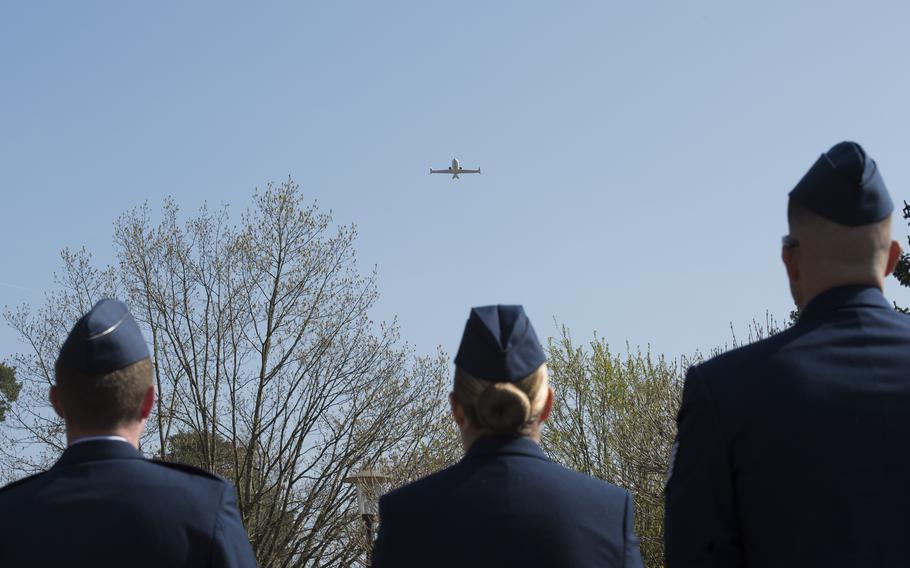
A C-21A from the 76th Airlift Squadron flies over Ramstein Air Base, Germany, April 10, 2025, to honor the victims of a 1996 plane crash in Croatia. The ill-fated flight was operated by the same squadron. (Zade Vadnais/Stars and Stripes)
RAMSTEIN AIR BASE, Germany — A memorial ceremony this week paid tribute to six Air Force crew members and 29 others killed nearly three decades ago when their plane crashed in Croatia, a disaster that broadly reshaped flight safety practices in the service.
Airmen gathered Thursday at this major hub for U.S. personnel for a wreath-laying and speeches commemorating the victims, who were part of a U.S. trade delegation to Croatia in the wake of the breakup of Yugoslavia.
Their CT-43A aircraft crashed into a mountainside during final approach to Dubrovnik Airport on April 3, 1996. The flight was operated by Ramstein’s 76th Airlift Squadron and carried Commerce Secretary Ron Brown, American business leaders, government staffers and Croatian nationals.
All but one of the 35 victims were killed on impact. The sole survivor, Tech. Sgt. Shelly Kelly, died later that day from her injuries.
On Thursday, a C-21A from the 76th Airlift Squadron performed a flyover in their honor. Members of the squadron will travel to Croatia this weekend to pay their respects at the crash site memorial near Dubrovnik Airport.
“Secretary Brown carried an offer for normalizing relations between the U.S. and a former communist enemy, the newly independent Croatia,” 86th Airlift Wing historian Shannon Murphy said during the ceremony. “This tragic accident began as a mission of peace, designed to forge stronger economic cooperation in the former Yugoslavia.”
As a result of the disaster, the 86th Airlift Wing’s commander, vice commander and operations group commander were relieved of duty. An accident investigation board concluded that poor planning and a series of in-flight errors were to blame.
The investigation also found that the aircrew had been allowed to use nonstandard approach procedures without major command approval, even though Air Force headquarters had denied a waiver request three months earlier.
Sweeping reforms were made across the Air Force in the wake of the crash, changes that still shape flight safety protocols, crew training and risk management practices.
The crash remains a case study in how lapses in oversight and deviation from standards can lead to devastating consequences.
As the Defense Department continues its broader push to reinforce discipline and readiness, leaders at Ramstein say the lessons from 1996 are more relevant than ever.
“As with everything we do in the military, standards, regulations and instructions govern the way we operate,” Brig. Gen. Adrienne Williams, 86th Airlift Wing commander, said at the ceremony.
“Many of the rules we live by may seem arbitrary to the casual observer, but nearly every safety rule and regulation can be said to have been written in blood. It is a tragic failure like this that drives the changes to our standards, safety practices and guiding regulations.”